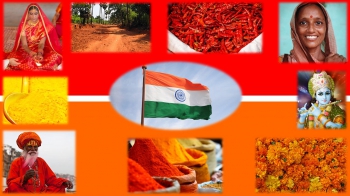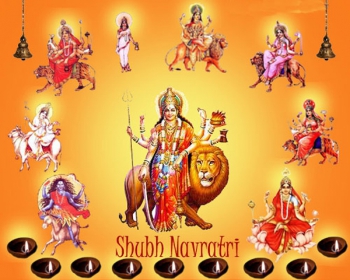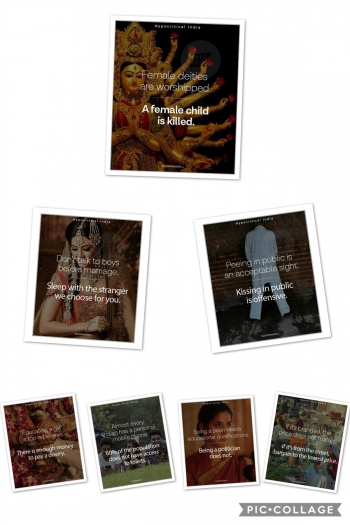09/25/2017
Why in India people don't wear black?
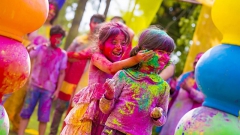 In India, colors are waltzing, everywhere, all the time. No need to wait for Holi, the festival where everyone throws colored powders and bombs to water at each other, to see red, yellow, purple, pink shimmering under the almost-daily sun. Indians wear colours on them, and it looks good. Especially Indian women.
In India, colors are waltzing, everywhere, all the time. No need to wait for Holi, the festival where everyone throws colored powders and bombs to water at each other, to see red, yellow, purple, pink shimmering under the almost-daily sun. Indians wear colours on them, and it looks good. Especially Indian women.
But why so many rainbows and no black? Is it because they see life in pink? Or because black attracts the sun's rays? If that was the reason, would it mean that Muslim women in desertic countries wearing dark colour niqabs or burqas are masochists?  Apparently, according to the Koran, black is not compulsory, whatever women cover themselves with must just be ugly, or at least it should be dull enough to not attract the (lusty) gaze of men – so much in European countries, where they get stared at for the same purpose of wearing a niqab or even just a hijab! So why do they chose black for this type of clothing? According to some, under a dark garment, as this color absorbs heat, it is so hot that you sweat, which in turn cools you down; It’s by the way the same explanation for the drinking of hot tea in burning countries. In India, the theory for tea was adopted, but not for wearing black.
Apparently, according to the Koran, black is not compulsory, whatever women cover themselves with must just be ugly, or at least it should be dull enough to not attract the (lusty) gaze of men – so much in European countries, where they get stared at for the same purpose of wearing a niqab or even just a hijab! So why do they chose black for this type of clothing? According to some, under a dark garment, as this color absorbs heat, it is so hot that you sweat, which in turn cools you down; It’s by the way the same explanation for the drinking of hot tea in burning countries. In India, the theory for tea was adopted, but not for wearing black.
 But why? Why is black colour has a negative connotation in spirituality and superstition (1)? Would it simply because it attracts mosquitoes, according to the popular belief – or at least to the belief of my nanny and my neighbor? CNN says it’s a myth. But the expert, in the interview, also says that what attracts mosquitoes is the carbon dioxide emitted by the body and the body heat. It goes in the sense of Muslim theories: we sweat more under a dark garment, and therefore the skin produces more carbon dioxide; and more definitely more heat since black absorbs it from the sun. So maybe it’s not completely a myth. And myth or not myth, I have noticed that mosquitoes prefer to rest on the dark things (door, bed, mirror) rather than on my white walls - and I have always thought they were shrewd enough to master camouflage techniques! (PS: did you know? Mosquitoes feed on plant nectar and don’t need blood as food but as a protein intake related to reproduction; vampires are all females!)
But why? Why is black colour has a negative connotation in spirituality and superstition (1)? Would it simply because it attracts mosquitoes, according to the popular belief – or at least to the belief of my nanny and my neighbor? CNN says it’s a myth. But the expert, in the interview, also says that what attracts mosquitoes is the carbon dioxide emitted by the body and the body heat. It goes in the sense of Muslim theories: we sweat more under a dark garment, and therefore the skin produces more carbon dioxide; and more definitely more heat since black absorbs it from the sun. So maybe it’s not completely a myth. And myth or not myth, I have noticed that mosquitoes prefer to rest on the dark things (door, bed, mirror) rather than on my white walls - and I have always thought they were shrewd enough to master camouflage techniques! (PS: did you know? Mosquitoes feed on plant nectar and don’t need blood as food but as a protein intake related to reproduction; vampires are all females!)
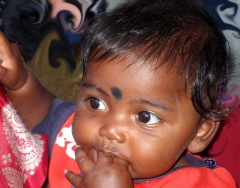 (1) Black is the color of evil, negativity and inertia; It symbolizes anger, darkness and is associated with the lack of energy, death though it is not the color of mourning. As a representation of evil, it is also used to combat the latter – take the form of the enemy to defeat him – as can be seen in the black dot applied on the face of infants to keep the dark evil eye at bay.
(1) Black is the color of evil, negativity and inertia; It symbolizes anger, darkness and is associated with the lack of energy, death though it is not the color of mourning. As a representation of evil, it is also used to combat the latter – take the form of the enemy to defeat him – as can be seen in the black dot applied on the face of infants to keep the dark evil eye at bay.
White is the absence of color; It’s the ‘non-color' worn at funerals and by widows throughout the rest of their lives, as a sign of renouncing all the pleasures/colors of life.
Red symbolizes violence, the fire that burns and therefore also the purity – in India fire has purifying virtues. It is also the color for the bride’s sari. Red also has connotations of sensuality, fertility and prosperity. Women wear a red dot on the forehead (see more about tilak, sindoor and bindi here). Favorite chilis are red. The super fertile earth is red in some areas. Orange or saffron, is the real color of fire and purity; When it is worn, it indicates its bearer has renunced the world and is in a quest for the sacred.
The yellow of the turmeric symbolizes holiness, blue is associated with the god Krishna, green represents renewal and joy. If you dig a little more, each color is associated with a certain God or goddess and represents its main qualities.
During the Holi festival: the pigments they throw at one another have very specific meanings: green for harmony, orange for optimism, blue for vitality and red for joy and love” (source: Wikipedia).
Another example is the color dress code to be observed during Navratri (from 21 to 29 September this year). Each of the 9 days of the festival is dedicated to one of the forms of the goddess Durga.
- Day 1 - Pratipada, goddess as ‘daughter of the mountains’ and consort of Shiva – Red for action and strength
- Day 2 - Brahmacharini, dispenser of happiness and prosperity – royal Blue for a quiet but powerful energy
- Day 3 - Chandraghanta, the goddess with a half moon on the forehead represents the beauty and the courage of the one fighting against the demons – Yellow, color that warms the heart
- Day 4 - Kushmanda, who created the universe covered with green vegetation – Green
- Day 5 - Skand Mata, who holds the infant Karthik in her arms – Gray for the vulnerability of the mother (who can turn into storm clouds to protect her little)
- Day 6 - Katyayani, when she was reborn as the daughter of the sage Kata as per his wish – Orange for courage
- Day 7 - Kalratri, black as night and very angry – White as her garment, and for peace and prayer
- Day 8 - The goddess is dressed in pink and destroys all sins of all times – Pink for a fresh start and renewal
- Day 9 - Siddhidatri with supernatural powers of healing – light Blue, like the cloudless sky
Sources: http://www.sensationalcolor.com/color-meaning/color-around-the-world/India-country-symbolic-colors-1935#.WB-kCMbYXIU ; https://www.theindusparent.com/significance-of-colours-in...
https://www.nbcnews.com/health/why-some-people-are-mosqui... ; http://Edition.CNN.com/2014/07/04/health/mosquito-bites-m...
08:00 Posted in Funny things about India in photos, Why in India... | Permalink | Comments (0) | Tags: india, colours, black, white, red, orange, blue, religion, spirituality, holi, navratri, durga, colour code, red dot on the forehead | ![]() Facebook | |
Facebook | |
09/18/2017
Indian ironies (1)
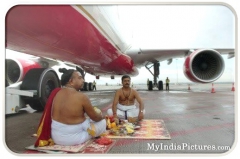 I often say that I find it very difficult to speak about India because whatever I can say about India is true, and the opposite as well. In other words, if I say something, anybody can also give me examples of the contrary; and we could both be right! To illustrate, here are some ‘Indian ironies’ available on the Net (I didn’t write them); I would have loved to find the same about the French but I didn’t…
I often say that I find it very difficult to speak about India because whatever I can say about India is true, and the opposite as well. In other words, if I say something, anybody can also give me examples of the contrary; and we could both be right! To illustrate, here are some ‘Indian ironies’ available on the Net (I didn’t write them); I would have loved to find the same about the French but I didn’t…
- We live in a country where seeing a cop makes us nervous rather than feeling safe.
- We are obsessed with screenguards on our smartphones even though most come with scratchproof Gorilla Glass but don't bother wearing a helmet while riding our bikes.
- It is shallow to ask for dowry but prospective bridegrooms should make six or seven figured salaries and possess green card.
- We live in a world, where artificial lemon flavour is used for WELCOME DRINK and real lemon is used in FINGER BOWL.
- Everyone is in a hurry, but no one reaches on time.
- Priyanka Chopra earned more money playing Mary Kom, than Mary Kom earned in her entire career.
- We'd rather spend more on our daughter's wedding than on her education.
- The shoes we wear are sold in AC showrooms. The vegetables we eat are sold on the pavement.
- Indian parents want their children to stand out in a crowd but expect them to do what the crowd is doing.
- We have to look both ways to cross a one-way road.
- India ranks 6th in the number of billionaires per country; it is also home to 1/3rd of the world extremely poor.
- You have to have studied till class 8th to become a peon; you don’t need any educational qualification to run the country.
- Peeing in public is an acceptable insight; kissing in public is offensive.
- Almost every Indian has a mobile phone; 60% of the population doesn’t have access to toilets.
- Don’t talk to boys before marriage; sleep with the stranger we choose for you.
- Female deities are worshipped; a female child is killed.
- If it is branded, the price doesn’t matter; if it’s from the street, bargain to the lowest price.
08:00 Posted in Incredible India! | Permalink | Comments (0) | Tags: india, contradictions, ironies | ![]() Facebook | |
Facebook | |
09/11/2017
About the importance of not working well in school in India...
08:00 Posted in Funny things about India in photos | Permalink | Comments (0) | ![]() Facebook | |
Facebook | |















